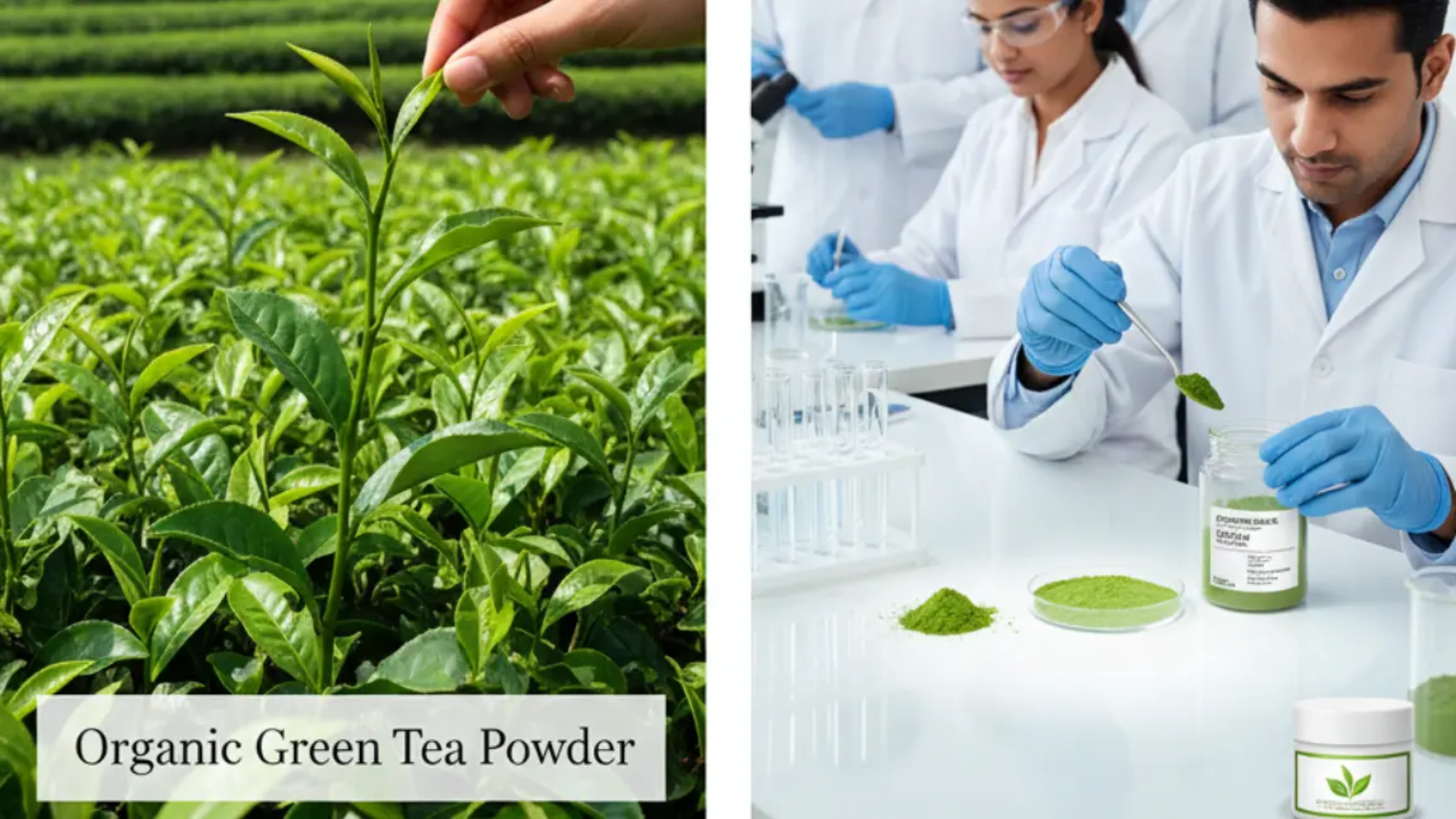The clean beauty revolution has transformed the cosmetics industry. Today’s consumers are ingredient-savvy, demanding products powered by natural, effective, and transparently sourced components. In this shift towards botanical-based skincare, one ingredient has risen to superstar status: Organic Green Tea Powder.
Prized for its potent, science-backed benefits for the skin, green tea is no longer just a healthy beverage; it’s a cornerstone of modern skincare formulation. However, not all green tea powder is created equal.
The powder you would use for a latte is different from what is required for a high-performance serum. For cosmetic brands, sourcing a true cosmetic-grade green tea is essential for creating products that are safe, effective, and luxurious.
This guide provides a crucial checklist for formulators, brand managers, and importers on what to look for when procuring this powerful clean beauty ingredient.
1. Potency of Key Actives: EGCG and Polyphenols
The primary reason green tea for skin is so effective is its high concentration of powerful antioxidants known as polyphenols. The most famous and potent of these is Epigallocatechin Gallate (EGCG). These compounds are the workhorses of the ingredient, providing key benefits:
Antioxidant Protection: They help neutralize free radicals caused by UV radiation and environmental pollution, protecting the skin from premature aging.
Soothing and Anti-inflammatory: They can help calm redness, soothe irritation, and reduce inflammation, making it ideal for sensitive or acne-prone skin formulations.
Anti-aging Support: They have been shown to help protect the skin’s natural collagen and elastin.
When sourcing, ask your supplier for a Certificate of Analysis (COA) that specifies the total polyphenol or EGCG content. A higher percentage indicates a more potent and effective ingredient for your skincare line.
Spice Up Your Business with Authentic Indian Flavors
Import and Export Excellence from India!

2. Purity and Verifiable Organic Certification
For a clean beauty ingredient, purity is non-negotiable. “Cosmetic-grade” means the powder must be meticulously clean and free from contaminants that could irritate the skin or compromise the final product.
The Organic certification is your first line of defense. It guarantees the tea was cultivated without synthetic pesticides, herbicides, or fertilizers. Beyond this, a reputable supplier must provide a COA that verifies the powder is free from:
Heavy metals (like lead and arsenic).
Harmful microbes (yeast, mould, bacteria).
This ensures the safety and integrity of your formulation.
3. Ultra-Fine Particle Size (Mesh)
This is a critical physical property for skincare formulation. A coarse, food-grade powder will feel gritty and abrasive in a topical product, creating a poor user experience.
Cosmetic-grade green tea powder should be micronized to an extremely fine particle size, often 200 mesh or finer. This ultra-fine texture ensures that it:
Creates a smooth, luxurious feel in creams, lotions, and serums.
Disperses evenly throughout a formula without settling.
Doesn’t feel abrasive in physical applications like face masks or exfoliants.
4. Vibrant Colour and Fresh Aroma
The sensory characteristics of the powder are direct indicators of its quality and freshness. Oxidized, old green tea powder loses its potency.
Colour: The powder should be a bright, vibrant green. A dull, brownish, or yellowish hue is a major red flag, indicating that the delicate antioxidant compounds have degraded. For products like clay masks, this vibrant green colour also adds to the natural, aesthetic appeal.
Aroma: It should have a fresh, clean, and grassy smell. A stale, dusty, or hay-like aroma points to old stock that has lost its effectiveness.
5. Sourcing from a Reputable and Knowledgeable Supplier
Finally, it’s essential to partner with a supplier who understands the specific, stringent requirements of the cosmetics industry. When sourcing from India, a major producer of fine teas, look for a partner who can:
Provide all necessary organic certifications (USDA, EU Organic, etc.).
Supply a detailed Certificate of Analysis (COA) with microbiological and heavy metal data.
Specify the particle size (mesh) of the powder.
Guarantee a consistent, high-quality supply chain.
By demanding these quality markers, beauty brands can confidently harness the true, scientifically proven power of this ancient botanical.
Frequently Asked Questions (FAQs)
1. Is the caffeine in organic green tea powder good for skin?
Yes, caffeine is a popular skincare ingredient. When applied topically, it has vasoconstrictive properties, which can help reduce puffiness and under-eye bags. It is also a potent antioxidant.
2. What is the difference between food-grade and cosmetic-grade powder?
The main differences are purity and particle size. Cosmetic-grade green tea undergoes stricter testing for microbes and heavy metals and is milled to a much finer powder to ensure a smooth texture in skincare products.
3. How do I incorporate the powder into an emulsion (cream/lotion)?
For best results, the fine powder should be dispersed in the glycerin or water phase of your formula before emulsification to ensure it is evenly distributed without clumping.
4. What is the recommended usage percentage in a formula?
The typical usage level for organic green tea powder in a skincare formula ranges from 0.5% to 5%, depending on the product type (e.g., a higher percentage for a wash-off mask, a lower percentage for a leave-on serum).
5. Will the green colour of the powder stain the skin?
At typical cosmetic usage levels, the vibrant green colour will not stain the skin, especially when formulated into a cream, lotion, or serum. In a wash-off mask, it provides a pleasant green tint that rinses away cleanly.
6. Can I use it in oil-based formulas like facial oils or balms?
While green tea powder is not oil-soluble, it can be suspended in oil-based formulas. Using an ultra-fine, micronized powder is essential to ensure it stays evenly dispersed and doesn’t feel gritty.
7. Does the “flush” or harvest time of the tea matter for cosmetic use?
While less critical than for drinking, teas from earlier flushes (like the first flush) often have a higher concentration of certain catechins and a more vibrant colour, which can be beneficial for cosmetic efficacy and aesthetics.
8. Why is “organic” so important for a cosmetic ingredient?
The skin can absorb substances applied to it. Using a certified organic ingredient ensures that you are not introducing unwanted pesticide residues or synthetic chemicals into your skincare formula, aligning with the core principles of the clean beauty movement.
About us
We bridge the gap between local producers and global markets, ensuring seamless trade facilitation with exceptional quality and reliability. We provide quick delivery services with customized packaging with all approval of International Certificates (Spices board India, MSME, IEC, fssai, FIEO, APEDA, EU certification, FDA and Many More)
Contact us
Shop No. 3, Ganesh Prestige Sr. No. 2/15, Near Laxmi Jewellers, Dhanakawadi, Pune – 411043, Maharashtra INDIA.
Call On
+91 9545205050
+91 9822422584



Leave A Comment